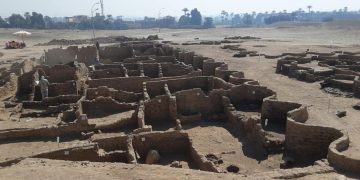A group of archaeologists have found the largest ancient city ever discovered in Egypt, dating back 3,000 years
The city was built more than 3,400 years ago during the opulent reign of Amenhotep III, one of Egypt’s most powerful pharaohs, according to the Egyptian archaeologist overseeing the excavations, Zahi Hawass.

The famed Egyptologist Zahi Hawass announced the discovery of the “lost golden city”, saying the site was uncovered near Luxor, home of the Valley of the Kings.
“The Egyptian mission under Dr Zahi Hawass found the city that was lost under the sands,” the archeology team said. “The city is 3,000 years old, dates to the reign of Amenhotep III, and continued to be used by Tutankhamun and Ay.”
It said the “city’s streets flanked by houses,” with intact walls up to 10 feet high and “rooms filled with tools of daily life … left by the ancient residents as if it were yesterday,” such as rings, colored pottery vessels, casting molds to make amulets, pots used to carry meat, and tools for spinning, weaving and metal and glass-making.

The team also found a large bakery, “complete with ovens and storage pottery,” whose size suggests it was used to cater to a “very large number of workers and employees.”
Items of jewellery such as rings have been unearthed, along with coloured pottery vessels, scarab beetle amulets and mud bricks bearing the seals of Amenhotep III.
Hawass, a former antiquities minister, said: “Many foreign missions searched for this city and never found it.”
The team began searching for a mortuary temple near Luxor in September, and within weeks found mud brick formations in every direction, Mr. Hawass said in a statement.
They unearthed the well-preserved city that had almost complete walls and rooms filled with tools of daily life along with rings, scarabs, colored pottery vessels and mud bricks bearing seals of Amenhotep’s cartouche.
Amenhotep III inherited an empire that stretched from the Euphrates to Sudan, archaeologists say, and died around 1354 BC.
He ruled for nearly four decades, a reign known for its opulence and the grandeur of its monuments, including the Colossi of Memnon – two massive stone statues near Luxor that represent him and his wife.
“The archaeological layers have laid untouched for thousands of years, left by the ancient residents as if it were yesterday,” the team’s statement said.
Bryan said the city “will give us a rare glimpse into the life of the Ancient Egyptians at the time where the empire was at his wealthiest”.
The team said it was optimistic that further important finds would be revealed, noting it had discovered groups of tombs it reached through “stairs carved into the rock”, a similar construction to those found in the Valley of the Kings.
“The mission expects to uncover untouched tombs filled with treasures,” the statement added.


































